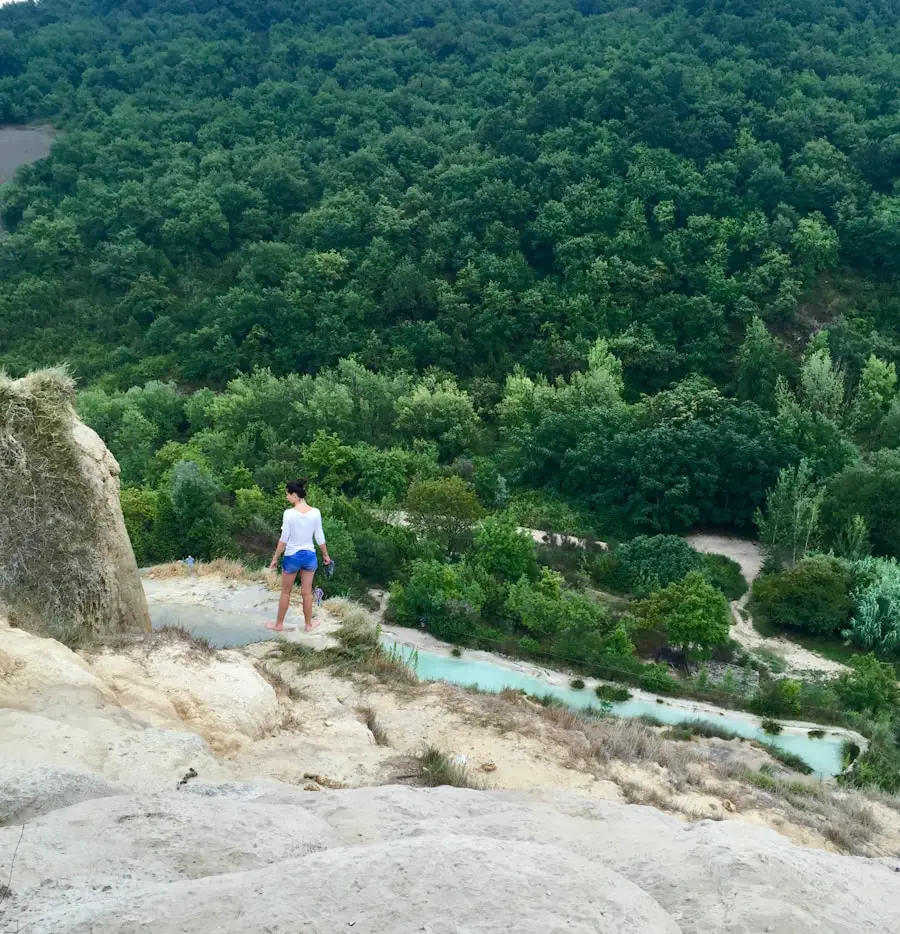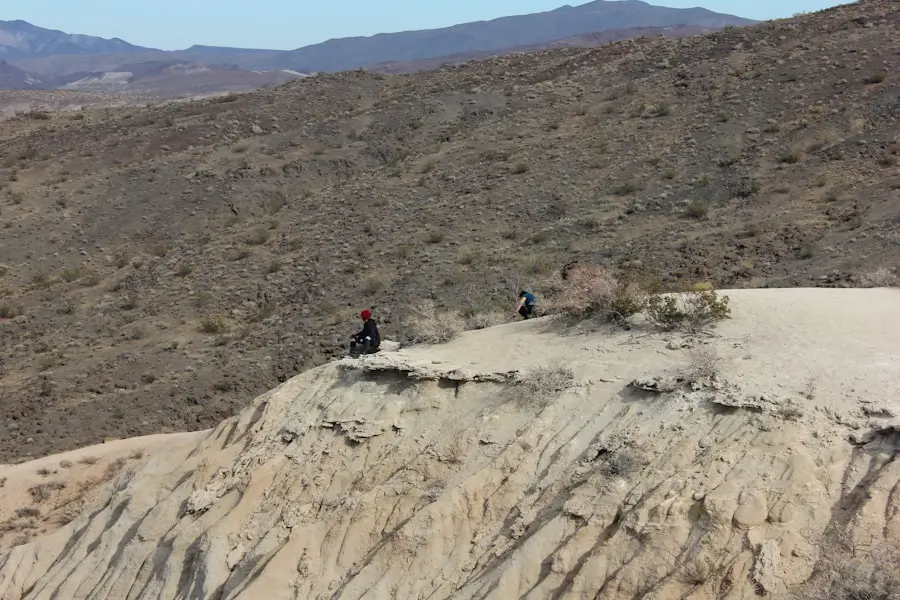Switchbacks are a common feature in hiking trails, particularly in mountainous or hilly regions. They are designed as zigzagging paths that ascend steep inclines, allowing hikers to gain elevation without the excessive strain that a direct vertical climb would impose. The design of switchbacks is not merely a matter of convenience; it is a carefully considered approach to trail construction that balances accessibility with the preservation of the natural landscape.
By creating a series of gradual turns, switchbacks reduce the steepness of the ascent, making it more manageable for hikers of varying skill levels. The construction of switchbacks involves strategic planning and engineering. Trail builders must consider factors such as the slope of the terrain, soil stability, and potential erosion.
A well-constructed switchback will have a gentle incline and a wide enough path to accommodate foot traffic while minimizing the impact on the surrounding environment. The turns in the trail are typically designed to be wide enough to allow for safe passage, while also providing scenic viewpoints that enhance the hiking experience. Understanding these fundamentals is crucial for anyone looking to navigate trails that feature switchbacks.
Key Takeaways
- Switchbacks are a series of zigzagging trail segments that help hikers ascend or descend steep terrain in a gradual manner.
- The purpose of switchbacks is to reduce erosion, protect the natural environment, and make hiking on steep terrain safer and more manageable.
- When navigating switchbacks, it’s important to maintain a steady pace, use proper foot placement, and take advantage of the natural curves in the trail.
- Hiking on switchbacks offers benefits such as reduced impact on the environment, improved safety, and a more enjoyable hiking experience.
- Common mistakes to avoid on switchbacks include cutting corners, creating new trails, and causing unnecessary damage to the surrounding ecosystem.
Understanding the Purpose of Switchbacks
The primary purpose of switchbacks is to facilitate a more gradual ascent or descent on steep terrain. By employing this zigzag pattern, trail designers can create a path that is less physically demanding, allowing hikers to conserve energy over long distances. This is particularly important in mountainous areas where direct routes can lead to exhaustion and increased risk of injury.
The switchback design also helps to distribute foot traffic more evenly across the trail, reducing wear and tear on specific areas and promoting sustainability. Moreover, switchbacks serve an essential role in erosion control. Steep, straight trails can lead to significant soil displacement and degradation, especially during rainstorms when water runoff can wash away loose soil.
By creating a series of switchbacks, trail builders can slow down water flow and allow it to percolate into the ground rather than rushing down the slope. This not only protects the trail itself but also preserves the surrounding ecosystem by preventing sediment from entering waterways and disrupting local flora and fauna.
Techniques for Navigating Switchbacks

Successfully navigating switchbacks requires a combination of physical technique and mental strategy. When approaching a switchback, it is essential to maintain a steady pace and be mindful of your footing. As you make the turn, shift your weight appropriately to maintain balance and avoid slipping.
It can be helpful to take shorter steps during these transitions, especially if the terrain is rocky or uneven. Engaging your core muscles can provide additional stability as you navigate the turns. Another important technique is to use your arms for balance.
As you turn, extend your arms slightly outwards to help maintain equilibrium. This is particularly useful when traversing narrow paths or when carrying a backpack that may shift your center of gravity. Additionally, it’s advisable to look ahead at the next segment of the trail rather than focusing solely on your feet.
This forward-looking approach allows you to anticipate changes in terrain and adjust your movements accordingly, making for a smoother navigation experience.
Benefits of Hiking on Switchbacks
| Benefits of Hiking on Switchbacks |
|---|
| 1. Reduced erosion |
| 2. Minimized impact on vegetation |
| 3. Improved safety for hikers |
| 4. Better trail sustainability |
| 5. Enhanced scenic views |
Hiking on switchbacks offers numerous benefits beyond just easing the physical demands of elevation gain. One significant advantage is the opportunity for enhanced scenic views. As you ascend or descend via switchbacks, you often encounter various vantage points that provide breathtaking panoramas of the surrounding landscape.
These moments can serve as rewarding breaks during your hike, allowing you to appreciate nature’s beauty while catching your breath. Additionally, switchbacks can foster a sense of accomplishment and progression. Each turn represents a small milestone in your journey, providing psychological boosts as you see how far you’ve come.
This can be particularly motivating on longer hikes where fatigue may set in. The gradual nature of switchbacks also allows for more frequent rest stops without feeling like you are losing ground, making it easier to enjoy the experience rather than simply focusing on reaching the destination.
Common Mistakes to Avoid on Switchbacks
While navigating switchbacks may seem straightforward, there are several common mistakes that hikers should be aware of to ensure safety and enjoyment on the trail. One frequent error is failing to maintain proper footing during turns. Many hikers underestimate the difficulty of navigating a switchback and may rush through turns without paying attention to their balance or the condition of the trail surface.
This can lead to slips or falls, particularly on wet or loose terrain. Another mistake is not being mindful of other hikers. Switchbacks can become congested, especially on popular trails.
It’s essential to communicate with fellow hikers when approaching turns or when you need to pass someone. Failing to do so can create confusion and increase the risk of accidents. Additionally, some hikers may neglect to take breaks during long ascents, thinking they need to push through without stopping.
This can lead to fatigue and decreased enjoyment of the hike; taking short breaks at strategic points along the switchbacks can help maintain energy levels.
Environmental Impact of Switchbacks

The construction and use of switchbacks have significant implications for environmental conservation and trail sustainability. When designed correctly, switchbacks can minimize soil erosion and protect delicate ecosystems from damage caused by foot traffic. However, poorly constructed or maintained switchbacks can exacerbate environmental issues, leading to increased erosion, habitat destruction, and water quality degradation.
Trail builders must consider local flora and fauna when designing switchbacks. For instance, if a trail passes through sensitive habitats or areas with endangered species, careful planning is necessary to avoid disrupting these ecosystems. Additionally, regular maintenance is crucial; over time, switchbacks may become eroded or overgrown with vegetation, necessitating repairs or rerouting to ensure continued sustainability.
How to Plan a Hike with Switchbacks
Planning a hike that includes switchbacks requires careful consideration of several factors to ensure a safe and enjoyable experience. First and foremost, it’s essential to research the trail beforehand. Many hiking guides and websites provide detailed information about trail conditions, including elevation profiles that highlight where switchbacks occur.
Understanding the layout of the trail can help you mentally prepare for the challenges ahead. Another critical aspect of planning is assessing your fitness level and experience with hiking on steep terrain. If you are new to hiking or unsure about your ability to navigate switchbacks, consider starting with shorter trails that feature less challenging inclines before tackling more demanding routes.
Additionally, packing appropriate gear is vital; sturdy footwear with good traction will help you navigate switchbacks safely, while trekking poles can provide extra stability on steep sections.
Tips for Mastering Switchbacks on Difficult Terrain
Mastering switchbacks on difficult terrain requires practice and patience, but several tips can enhance your skills and confidence as you tackle these challenging sections of trail. One effective strategy is to focus on your breathing; maintaining a steady rhythm can help regulate your energy levels and keep fatigue at bay during steep climbs or descents. Inhale deeply through your nose and exhale through your mouth as you navigate each turn.
Another useful tip is to visualize each turn before you reach it. Anticipating the upcoming switchback allows you to adjust your pace and prepare mentally for the transition ahead. Additionally, consider using landmarks along the trail as reference points; this can help break up the hike into manageable segments and provide motivation as you reach each point along the way.
Finally, practice makes perfect; if possible, seek out local trails with switchbacks to hone your skills before embarking on more challenging hikes. Familiarizing yourself with different types of terrain will build confidence and improve your ability to navigate various conditions effectively. By incorporating these techniques into your hiking routine, you’ll find yourself mastering switchbacks in no time, enhancing both your skills and enjoyment of outdoor adventures.
Switchbacks are a common feature in hiking trails, especially those with steep inclines. These zigzagging paths help hikers ascend or descend more gradually, making the journey safer and more manageable. For those looking to combine hiking with fishing, having a portable fishing rod like the ones recommended in this article can make for a versatile and enjoyable outdoor adventure.
Love travel? Join Our Facebook Community For More Tips.
FAQs
What are switchbacks in hiking?
Switchbacks are a hiking trail design technique that involves a series of zigzagging or hairpin turns in the trail to help reduce the steepness of the ascent or descent.
Why are switchbacks used in hiking trails?
Switchbacks are used in hiking trails to make steep inclines or declines more manageable for hikers. They help to reduce the overall elevation gain or loss and make the trail more sustainable by preventing erosion.
How do switchbacks benefit hikers?
Switchbacks benefit hikers by making steep sections of the trail easier to navigate. They reduce the physical strain on hikers by breaking up the ascent or descent into shorter, more gradual segments.
Are switchbacks environmentally friendly?
Yes, switchbacks are environmentally friendly because they help to minimize erosion on the trail. By reducing the steepness of the trail, switchbacks help to prevent soil erosion and protect the natural landscape.
Do all hiking trails have switchbacks?
Not all hiking trails have switchbacks, but they are commonly used on trails with steep inclines or declines. The use of switchbacks depends on the terrain and the trail design.
